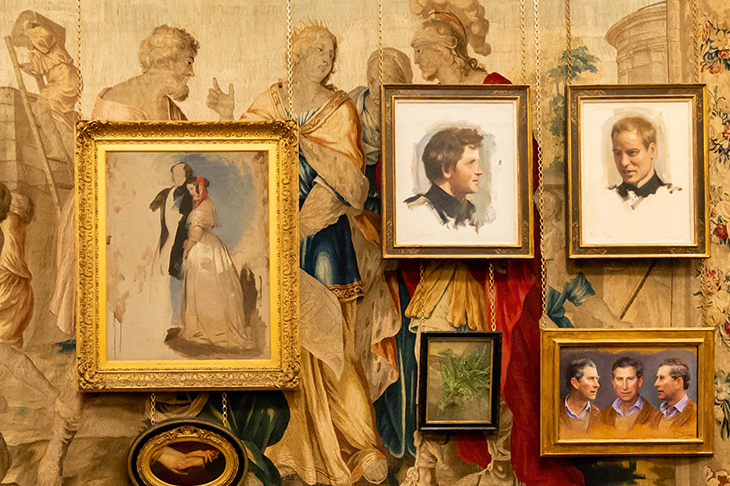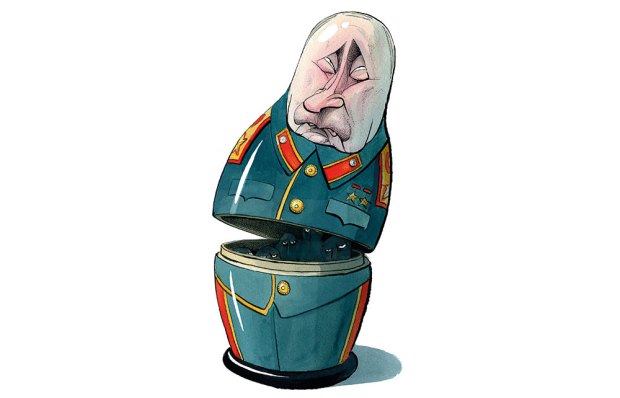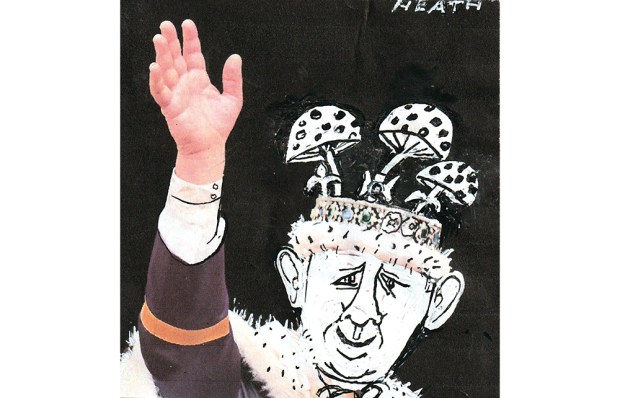It’s like any traditional bazaar. Cushions litter the floor and crowds gather around displays of Chinese pottery and Persian rugs. Tea cups stand ready to celebrate a hard-bartered purchase. Except no tea will be poured: this market happens to be in the middle of a stateroom in Buckingham Palace and is the centrepiece of the Prince of Wales’s new exhibition showcasing his favourite pieces of art and craftsmanship. The show is titled ‘Prince and Patron’, and it is packed to the brim with objects he loves.
It also offers a glimpse of what the eventual reign of King Charles III may look like. There has been court gossip that the Prince will choose another name to reign with rather than be identified with the two previous monarchs called Charles. It is a rumour he has never acknowledged; and it is surely no coincidence that one of the first artworks visitors see in the exhibition is a triple portrait of the Prince of Wales that is an almost exact copy of van Dyck’s famous painting of King Charles I. Nearby is also Verrio’s study of Charles II. These are not the choices of a man keen to distance himself from his namesakes.
Horticultural and architectural drawings remind the visitor of the Prince’s involvement in controversial issues such as the environment, a habit that has fascinated Britain’s media for decades. The Guardian spent five years and thousands of pounds in court battles to gain access to the infamous ‘Black Spider’ memos, in which the Prince expressed his concern over matters that included the plight of the Patagonian toothfish and the lack of support being given to British troops in Iraq. The obsession stems from the fact that while the Queen has always remained remarkably discreet about what she thinks, her son and heir has never been afraid to make his views heard.
 A useful primer for the reign of Charles III
A useful primer for the reign of Charles III
When he does speak, it enrages a very particular elite group in society, regardless of what he says. What emerged from the memos was that many of the views the Prince holds resonate with the vast majority of the British public. For instance, in 1984 Charles railed against modern architecture, to the ire of metropolitan liberals. And yet more than 30 years on, a survey by the planning researchers Create Streets shows that 87 per cent of the public prefer historic architecture over modern or brutalist designs. This spirit is on show in the exhibition, with charcoal sketches of Georgian squares in London overshadowed by brutalist tower blocks and glass skyscrapers.
Trying to decipher his personal views through the medium of art is a tricky business, but there are some unexpected items chosen by the Prince that give quite unambiguous insights into what he thinks. On a wall beside images of his royal forebears and of his own sons, the Dukes of Cambridge and Sussex, sits the exhibition’s only portrait of a recent Prime Minister.
In melancholic watercolour, the face of Harold Macmillan stares out at the tourists who have come to visit Buckingham Palace. ‘Supermac’ ran Britain from 1957 until 1963 and exemplifies a type of conservatism based around the principle of noblesse oblige. The descendant of a Scottish crofter, he presided over an era when his fellow countrymen ‘had never had it so good’ and transitioned many former British colonies in Africa into independent states. It was part of a decolonisation policy that enraged his fellow conservatives at the time.
While a minister in Winston Churchill’s post-war government, Macmillan spearheaded the greatest period of housebuilding Britain had ever seen; and when in power he moved the country towards a planned economy. Deeply concerned with the plights of the ordinary working man, despite being a member of the country’s ruling class, he was a champion of what he called the ‘Middle Way’, and it is not hard to see why Prince Charles would feel a special affinity with him.
In a 17th-century oil painting on the opposite wall, St Jerome is buried deep in his translation of the Bible. While he is known for his translation of the Vulgate, there is another aspect of the Catholic saint’s life that it is likely the Prince of Wales identifies with. Jerome would speak out on any matter that took his interest, and he enraged the elite of Rome with his expressed opinions. He taught anyone who listened that they could live full lives as Christians even though they were surrounded by the temptations of cosmopolitan urban life. He was later hounded out of Italy, retiring to live as a hermit in a monastery in the Holy Land.
Questions over the Prince’s religious views have dogged him in recent years, with journalists and commentators claiming that when he becomes king he will want to be known as ‘Defender of Faith’ rather than the traditional ‘Defender of the Faith’. Courtiers dismiss the idea as nonsense, but the accusation has never truly disappeared. The Prince’s interest in religions other than the Church of England is highlighted in this exhibition. Near three Orthodox icons, four traditional Buddhist thangkas shine in the light on one wall of the room, displaying Green Tara, the goddess of compassion, Saraswati, the goddess of arts, music and eloquence, Sakyamuni Buddha, the founder of Buddhism, and White Tara, the goddess of long life and good health. These exhibits, like everything on show, are not accidental.
It does not need pseudy examination to see where the Prince’s interests lie, geographically. The man is an unapologetic Orient-alist. ‘Enjoy this exhibition as you would a souk or bazaar,’ he purrs into visitors’ headphones. A piece of Tipu Sultan’s throne and a girdle of a Sikh Maharaja glitter from India, which became a republic when the prince was two, but which he visits more than almost any other country.
The centrepiece of the show is the Afghan carver Nasser Mansouri’s pavilion filled with carpets and fabrics from his country, all made by craftsmen and women from the Prince’s charity Turquoise Mountain. This he set up with Rory Stewart, Tory MP for Penrith and the Border. Besides things of the past, reminders of the chaos of the present are given prominence. A portrait of Yazidi women rescued from the clutches of Isis is one of the final pictures on show.
The Queen stands out among most of her predecessors for not being a great patron of art. Since taking the throne, comparatively few items have been purchased by her for the Royal Collection — just 20 in her first 50 years — and of those almost all are works depicting other royals. What she has added reinforces her public image as a safe, traditional monarch whose private opinions remain hidden from the public eye.
Her son, meanwhile, has spent longer as an heir than any of his predecessors and has had plenty of time to devote to his art collection. As hard as it is for many to acknowledge, it will not be long before he becomes Britain’s monarch. If his collection is anything to go by, the future King Charles III will have no fear of telling Britain and its governments exactly what he thinks.
Got something to add? Join the discussion and comment below.
Get 10 issues for just $10
Subscribe to The Spectator Australia today for the next 10 magazine issues, plus full online access, for just $10.
You might disagree with half of it, but you’ll enjoy reading all of it. Try your first month for free, then just $2 a week for the remainder of your first year.














Comments
Don't miss out
Join the conversation with other Spectator Australia readers. Subscribe to leave a comment.
SUBSCRIBEAlready a subscriber? Log in